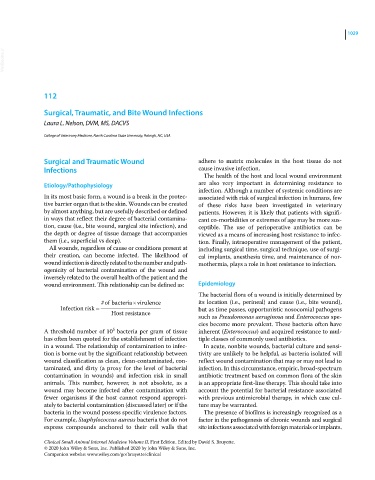Page 1091 - Clinical Small Animal Internal Medicine
P. 1091
1029
VetBooks.ir
112
Surgical, Traumatic, and Bite Wound Infections
Laura L. Nelson, DVM, MS, DACVS
College of Veterinary Medicine, North Carolina State University, Raleigh, NC, USA
Surgical and Traumatic Wound adhere to matrix molecules in the host tissue do not
Infections cause invasive infection.
The health of the host and local wound environment
Etiology/Pathophysiology are also very important in determining resistance to
infection. Although a number of systemic conditions are
In its most basic form, a wound is a break in the protec- associated with risk of surgical infection in humans, few
tive barrier organ that is the skin. Wounds can be created of these risks have been investigated in veterinary
by almost anything, but are usefully described or defined patients. However, it is likely that patients with signifi-
in ways that reflect their degree of bacterial contamina- cant co‐morbidities or extremes of age may be more sus-
tion, cause (i.e., bite wound, surgical site infection), and ceptible. The use of perioperative antibiotics can be
the depth or degree of tissue damage that accompanies viewed as a means of increasing host resistance to infec-
them (i.e., superficial vs deep). tion. Finally, intraoperative management of the patient,
All wounds, regardless of cause or conditions present at including surgical time, surgical technique, use of surgi-
their creation, can become infected. The likelihood of cal implants, anesthesia time, and maintenance of nor-
wound infection is directly related to the number and path- mothermia, plays a role in host resistance to infection.
ogenicity of bacterial contamination of the wound and
inversely related to the overall health of the patient and the
wound environment. This relationship can be defined as: Epidemiology
The bacterial flora of a wound is initially determined by
# of bacteria virulence its location (i.e., perineal) and cause (i.e., bite wound),
Infection risk but as time passes, opportunistic nosocomial pathogens
Host resistance
such as Pseudomonas aeruginosa and Enterococcus spe-
cies become more prevalent. These bacteria often have
5
A threshold number of 10 bacteria per gram of tissue inherent (Enterococcus) and acquired resistance to mul-
has often been quoted for the establishment of infection tiple classes of commonly used antibiotics.
in a wound. The relationship of contamination to infec- In acute, nonbite wounds, bacterial culture and sensi-
tion is borne out by the significant relationship between tivity are unlikely to be helpful, as bacteria isolated will
wound classification as clean, clean‐contaminated, con- reflect wound contamination that may or may not lead to
taminated, and dirty (a proxy for the level of bacterial infection. In this circumstance, empiric, broad‐spectrum
contamination in wounds) and infection risk in small antibiotic treatment based on common flora of the skin
animals. This number, however, is not absolute, as a is an appropriate first‐line therapy. This should take into
wound may become infected after contamination with account the potential for bacterial resistance associated
fewer organisms if the host cannot respond appropri- with previous antimicrobial therapy, in which case cul-
ately to bacterial contamination (discussed later) or if the ture may be warranted.
bacteria in the wound possess specific virulence factors. The presence of biofilms is increasingly recognized as a
For example, Staphylococcus aureus bacteria that do not factor in the pathogenesis of chronic wounds and surgical
express compounds anchored to their cell walls that site infections associated with foreign materials or implants.
Clinical Small Animal Internal Medicine Volume II, First Edition. Edited by David S. Bruyette.
© 2020 John Wiley & Sons, Inc. Published 2020 by John Wiley & Sons, Inc.
Companion website: www.wiley.com/go/bruyette/clinical

